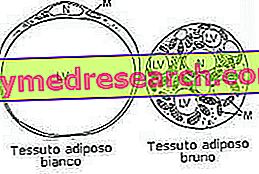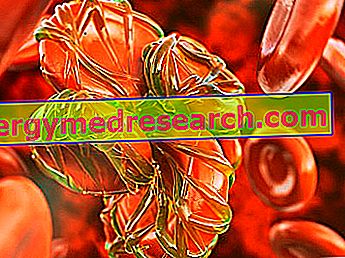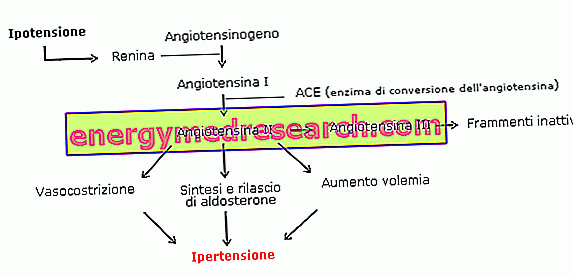Characteristics of brown adipose tissue, "physiological antiobesity tissue"
The role played by brown adipocytes is different from that covered by white adipocytes. First of all because they are smaller cells, whose dark color is due to the presence of cytochromes contained in the numerous mitochondria. Unlike the white adipocyte, brown adipocytes do not contain a single large fat mass but many small drops of triglycerides, called lipid vacuoles. Consequently the nucleus and the cytoplasm are not located in the periphery but well distinguishable inside the cell. Besides a morphological difference there is also a functional one.

If the body suffers from hypothermia, brown adipocytes respond by mobilizing their own triglycerides, from whose catabolism dissipable energy is released in the form of heat.
This phenomenon is called shiver-free thermogenesis, to distinguish it from the classic shiver (involuntary muscle contraction directed to the production of heat).
The brown adipose cell, which is the cell of the body richest in mitochondria, contains a mitochondrial protein, called UCP-1 (disaccopiante protein), which is the real marker of this adipocyte and intervenes in thermogenesis. When a sympathetic stimulus arrives, thanks above all to B3-adrenergic receptors, thermogenetic activity is activated. Genetically deprived mice of these receptors undergo a phenomenon of transdifferentiation of brown adipose tissue, which is transformed into white adipose tissue making them massively obese despite greater physical activity and the normocaloric diet.
Brown adipose tissue has a rich sympathetic innervation which makes it particularly sensitive to the activity of catecholamines, hormones secreted rapidly in response to acute psychophysical stress.
Brown adipose tissue is activated, not only in response to a drop in temperature, but also in the event of excessive caloric intake with the diet. In theory this phenomenon, based on the dispersion of the caloric surplus in the form of heat, should guarantee the homeostasis of body weight, independently of the food excesses.
An increase in thermogenesis has been shown in hypernutrite rats, with a preventive effect on the development of obesity. Brown adipose tissue responded to this condition with the same metabolic and structural changes activated during cold thermogenesis. Not surprisingly, as soon as you have eaten, the temperature increases by about 0.5 / 1 degree, precisely because of this form of postprandial thermogenesis mediated by brown adipose tissue, which tends to keep the body's energy balance stable despite the meal's calorie surplus.
The experimental animal exposed to cold for ten days transforms the phenotype of its adipose organ into a predominantly brown phenotype. The surprising thing is that not only the percentages of white / brown adipocytes change, but that the total number of fat cells remains constant; this means that under certain conditions mature white adipocytes can turn into brown adipocytes, and vice versa.

In genetically obese rats, brown adipose tissue has a reduced thermogenetic capacity.
The reduced presence of brown adipocytes in an adult individual therefore appears to be one of the many pathogenetic mechanisms underlying obesity.
According to the most recent studies, the adipose tissue of mammals (including humans) has the intrinsic capacity to transform white adipocytes into brown adipocytes, and vice versa. Indeed, brown adipose tissue is not numerically constant in its cell population, but expands and shrinks as needed. This event is due to hyperplasia and conversion of white adipocytes into brown adipocytes; the cohabitation of these cells is in fact antithetic (the white ones accumulate the lipids while the brown ones burn them). The discovery of these biological mechanisms opens the door to future therapeutic developments in the treatment of obesity; theoretically, in fact, to defeat it would be sufficient to increase the percentage of brown adipocytes, which is also very useful in the prevention of diabetes.



